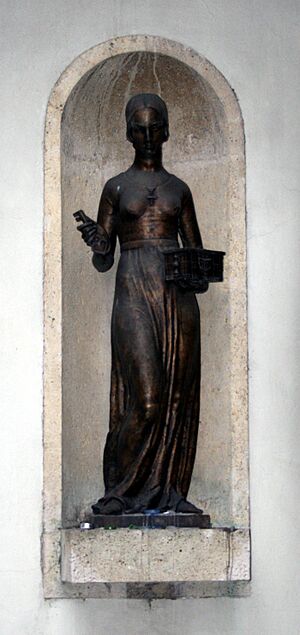Ivo Kerdić facts for kids
Quick facts for kids
Ivo Kerdić
|
|
|---|---|
| Born | 19 May 1881 |
| Died | 27 October 1953 (aged 72) |
| Nationality | Croatian |
| Education | Vienna, Paris |
| Known for | sculpture, metalwork |
Ivo Kerdić (1881–1953) was a famous Croatian artist. He was a sculptor, which means he made art by shaping materials. He was especially known for his amazing metalwork and small, round art pieces called medallions.
Contents
Life Story of Ivo Kerdić
Ivo Kerdić was born on May 19, 1881, in a small village called Davor. This village is near Slavonski Brod in Croatia. At that time, Croatia was part of a larger country called Austria-Hungary.
His father was a wood merchant. Ivo went to elementary school for four years. After that, he moved to Zagreb to learn how to be a locksmith. He studied this trade at a school for artisans.
In 1900, Ivo went to Paris, France. He worked during the day to earn money. In the evenings, he studied applied art, where he learned how to engrave. This means carving designs into metal or other materials.
He came back home a year later because his father passed away. He didn't have enough money to go back to Paris to finish his studies. So, in 1902, Kerdić went to Vienna, Austria. He worked at a place called the Gillar Bronze Factory. He was very good at his job and became a foreman, which is like a team leader.
Kerdić returned to Zagreb in 1913. He started working as a teacher at the College of Arts and Crafts. He was a pioneer in bronze casting. This is a special way of making sculptures using melted bronze. He taught metalworking at the Academy of Fine Arts from 1923 to 1947.
Ivo Kerdić passed away in Zagreb on October 27, 1953.
Ivo Kerdić's Art and Work
Kerdić created many different types of art. Some were useful items, known as applied art. He also made portraits of people and sculptures of figures.
You can see some of his sculptures in churches. For example, there are pieces in the main and side altars of the St. Blaze church in Zagreb. There's also an altar in the St. Cyril and Methodius church in Jerusalem. In Zagreb, on Miramarska road, you can find a crucifix made by Kerdić.
Even though he used many materials, Kerdić is most famous for his metalwork. He was especially known for making medals and medallions. He is considered one of the best artists of his time in this area.
Kerdić designed important items like the chain for the Rector of Zagreb University. He also made the chain for the Grand Master of the Brethren of the Christian Dragon. He created medals for the Independent State of Croatia, such as the Crown of King Zvonimir medal.
Where to See His Art
You can find many of Ivo Kerdić's medals and medallions in the Numismatic collection at the Archaeological Museum in Zagreb. This collection has about 160 of his works, made from 1911 onwards. A numismatic collection focuses on coins, medals, and paper money.
The Modern Gallery in Zagreb has an even larger collection of Kerdić's art. They have 625 original pieces! These include medals, plaques, badges, award medals, coins, and sculptures. These works were created between 1905 and 1953. His art gives us a look into public life in Zagreb and Croatia during his time. It shows famous people and important political topics of that era.
Exhibitions of His Work
Kerdić's art has been shown in many exhibitions.
Solo Exhibitions
These are shows where only his work was displayed:
- 2011: "Ivo Kerdić – Celebrating the 130th anniversary since the birth of the sculptor" at the Modern Gallery, Zagreb.
- 2004: "Ivo Kerdic works from the permanent collection" at the Archeological Museum of Zagreb.
Group Exhibitions
These are shows where his work was displayed alongside other artists:
- 1931: Belfast Museum and Art Gallery Exhibition of Yugoslav Paintings and Sculpture.
- 1930: Exhibition of Yugoslav Pictures and Sculpture at the Glynn Vivian Art Gallery in Swansea.
Public Collections
His art can be found in these public museums and galleries:
- Archeological Museum in Zagreb, Croatia
- Modern Gallery, Zagreb, Croatia
- Glyptotheque Sculpture Museum, Croatian Academy of Sciences and Arts
- Croatian History Museum



